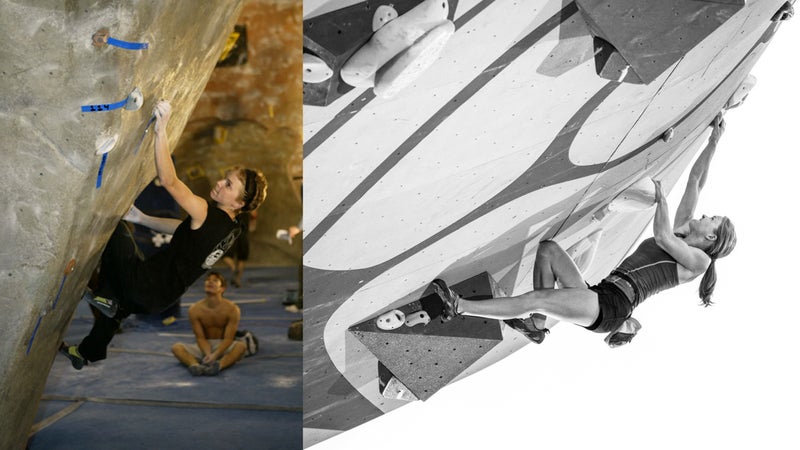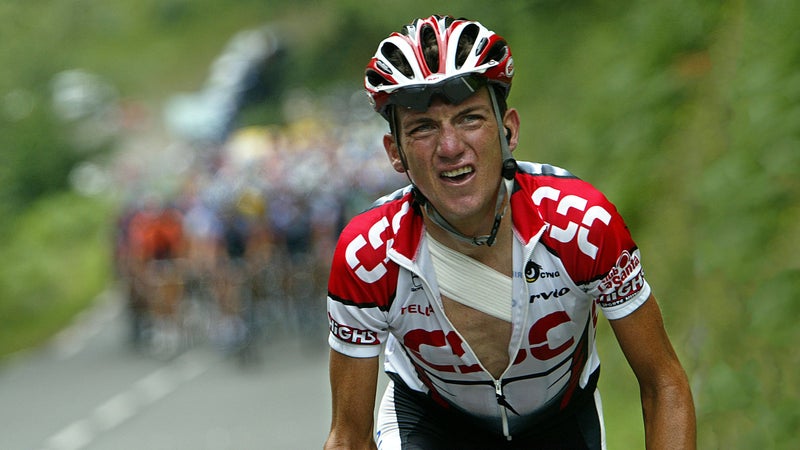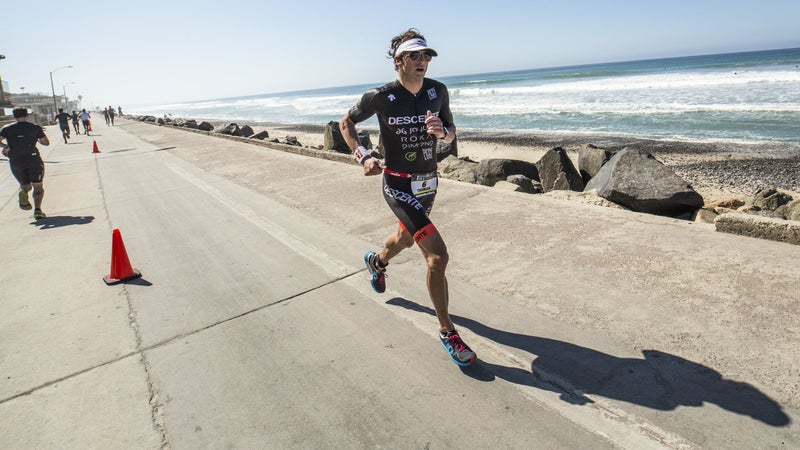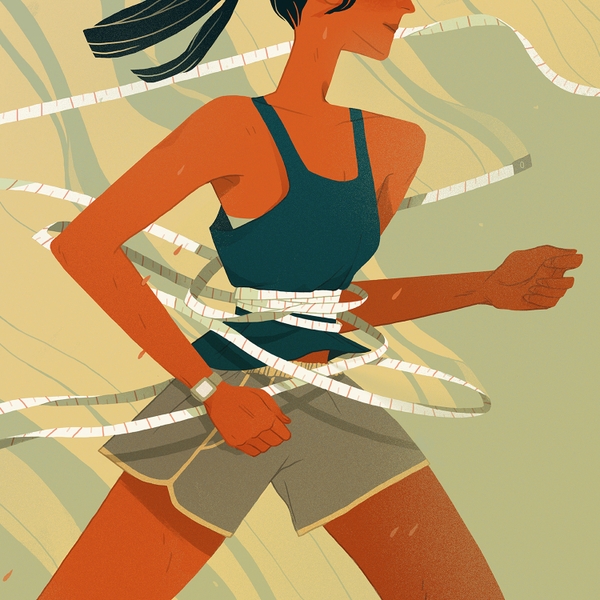The Inextricable Tie Between Eating Disorders and Endurance Athletes
Climbers, cyclists, runners, and all kinds of other athletes—both men and women—are starting to speak out about disordered eating in their communities
New perk: Easily find new routes and hidden gems, upcoming running events, and more near you. Your weekly Local Running Newsletter has everything you need to lace up! .
Looking back on her early days in her sport, professional climber Angie Payne, 32, is struck by how twisted her definition of health once was. She started climbing at age 11 and quickly became, in her words, “obsessed”: she loved the feeling that when she got on the wall, her body became graceful and intuitive in a way she’d never experienced before—that some part of her naturally understood what to do. She had talent. She was also a skinny kid, which helps in a sport that puts the strength of your muscles in direct ratio to the body mass they have to haul toward the sky.
Payne stayed naturally thin when she hit puberty, even though her diet growing up in Cincinnati, Ohio, consisted mostly of “sugar, butter, and some veggies here and there.” In her mid-teens, she started thinking about eating healthier—not so much because she wanted to lose weight, but because it made her feel like she was getting serious about climbing, pushing her Midwestern adolescent life in the direction of her lofty athletic dreams. “I remember the first thing I did was that I started eating a lot more salad,” says Payne. “Salad in my family was iceberg lettuce with sugar dressing and a lot of croutons.” Before long, she says, “I’d come home from the gym, and all I’d eat after climbing the whole night was a salad” with “no protein, nothing.” In her mind, salad equated to healthy, but looking back, she says, “Really, that was the beginning.”
About 30 million Americans, or about 10 percent of the population, suffer from eating disorders.
After graduating from high school, Payne moved to Boulder, Colorado, enrolled in college to appease her parents, and devoted herself to competitive climbing. On her own for the first time, she was lonely and depressed—feelings she channeled into not only her training but also an increasingly rigid diet. The list of foods she deemed “healthy” shrank and shrank. Breakfast became a handful of granola, lunch a chicken breast, dinner a salad. She avoided scales—the moment she started quantifying her weight loss, some part of her felt she’d have to admit she had a problem. But she could feel the changes in the body: Her skin dried out, and her hair felt like straw. She stopped getting her period. But on the climbing wall, her newfound lightness was “addicting,” she says. She started winning one national competition after another. She remembers one day when she tried a difficult move on crimps—small holds that the climber can grasp only with her fingertips—and felt like she was “just flowing over the boulder,” weightless.
Payne wanted to lose weight to win, but once her eating disorder took hold, winning ceased to make her happy. Instead, it became the only thing standing between her and the emotional tailspin that came with a loss. She felt stuck: If she acknowledged she had a problem, she would have to put on weight, and if she gained any weight, she was convinced she’d lose her edge in competitions. The thought of losing filled her with despair.
One night at her parents’ house, in the spring of 2004, Payne stepped on a scale for the first time in months and learned that she weighed less than 100 pounds, down from about 120 at the beginning of the school year. “I remember looking in the mirror,” she says. She took in the dramatic changes to her body. She’d never imagined that she’d lost so much weight. “I remember thinking, ‘Oh my god, this is really, really unhealthy.’”

Payne would eventually be diagnosed with anorexia nervosa, but only after she hid her eating disorder for the better part of a year, even, to some extent, from herself. In the world of professional climbing—and, more generally, across endurance sports—Payne’s obsession with eating “perfectly” didn’t look as abnormal as it should. , or about 10 percent of the population, suffer from eating disorders such as anorexia and bulimia, and many more exhibit signs of disordered eating. The incidence is believed to be slowly rising.
Efforts to measure the prevalence of eating disorders among athletes have returned varying results, but it’s generally accepted that the rate is higher than in the general population. of elite athletes in Norway found that 13.5 percent had eating disorders, including 9 percent of male endurance athletes and 24 percent of female athletes. Athletes are under the same pressures as everyone else to conform to a societal standard of thinness and beauty, but they also contend with their own set of risks, according to Ron Thompson, a specialist who has consulted on the topic of eating disorders with the NCAA and the . Those triggers turn out to be the same traits we admire in athletes, the mental assets that allow the human body to perform seemingly superhuman feats. For example, “How many people can run several miles after not having eaten for several days?” Thompson asks. For clinicians like Thompson, the battle begins with making coaches see these behaviors as dangerous, rather than as the essence of an athlete’s competitive edge.
Efforts to measure the prevalence of eating disorders among athletes have returned varying results, but it’s generally accepted that the rate is higher than in the general population.
Slowly, the world of endurance sports has begun to reckon with these dangers. As recently as the 1980s and 1990s, “anorexia wasn’t a term that was used very much,” says former elite runner Lize Brittin, who . “I didn’t know what I had.” Women runners, including Brittin, were among the earliest endurance athletes to speak openly about their struggles. Experts and advocates are currently working to expand the perception of who suffers from eating disorders. For years, clinicians focused on the female athlete triad, the idea that disordered eating is one of an interrelated set of problems, along with amenorrhea—when a woman ceases to get her period—and osteoporosis, both of which can result from malnutrition. This framework left no room for male athletes or for many of the worst consequences that can come from eating disorders, such as compromised immunity, heart problems, or organ failure. In 2014, the the term “” in its official statements with the more inclusive term “relative energy deficiency in sport (RED-S)”; in 2015, .
Today, the conversation about eating disorders in endurance sports increasingly includes men’s voices as well as women’s and the testimony of swimmers, cyclists, skiers, and climbers in addition to runners. Former Olympic cyclist Mara Abbott established herself as one of the on the issue last summer. Nordic skier Hannah Halvorsen recruited other women in her sport to make a video about their struggles with body image. In the past year, moving personal essays about the topic from , , and have made waves online. Confronting this issue may require recognizing that the whatever-it-takes mentality and its attendant dangers are an inextricable part of elite endurance sports. “Being a professional athlete isn’t actually a super-healthy thing to do,” says Abbott. From training to nutrition, “It’s always about managing stresses—about how much a body can withstand.”

One of the first things learned on day one of his career as a professional cyclist was that he needed to lose weight. It was 1995, and he’d just touched down in the Barcelona airport, having signed a contract with U.S. Postal Service. When the team director picked him up, “He made fun of my baby fat straightaway,” Hamilton recalls. “I was like, ‘What’s this about? I’m super skinny!’ I had no idea.”
While female athletes, like women in general, are inculcated all their lives with the importance of thinness, male athletes are also bombarded with messages about their bodies. Some of the cyclists and runners I interviewed—both men and women—told me they think coaches and directors on women’s teams have grown more attuned to the issue, and, in many cases, are more careful with what they say about an athlete’s weight or eating, while men’s coaches are years behind.
Early in his career, Hamilton thought of himself as a “big engine”—sure, he had bulkier muscles than some of his beanpole teammates, but that’s what powered him to victory in his best stage: the time trial. But after a few years of feeling his team’s nutritionists “eyeballing me every time I went up to get a cookie,” and of hearing from coaches and more seasoned cyclists that he could really be a contender if he shed a few pounds, Hamilton took the advice to heart. “When I lost weight, I basically learned to climb,” he told me. “There was a time”—around 2003, when he placed fourth in the Tour de France—“when I was one of the best climbers in the world.”
For athletes, eating disorders are often desperate attempts to excel at the sports that comprise their entire lives and form the basis of their identities.
Every spring and summer, the 5’8″ Hamilton would work to whittle himself down to about 130 pounds. “The three months before the Tour were hell to get there,” he says. He’d bike for six or seven hours, come home famished, and chug a Diet Coke as fast as he could. A Diet Coke, and maybe an apple, and “you go from ravenous to ‘okay, maybe I can go another hour now.’” Once, after a hard training ride, Hamilton’s director gave him a handful of sleeping pills to help him “make it until dinner” without eating. The message was, “If you make it through the night, even better.”
Hamilton describes these patterns as an eating disorder, though he was never technically diagnosed with one. At the same time, he believes achieving a skeletal physique did make him a better cyclist. Weight is only one of many factors in an athlete’s performance. But in races that are won and lost by a fraction of a second—not only in cycling, but also in running, swimming, and skiing—athletes who fantasize about the perfect ratio between power and leanness usually find that the latter is easier to quantify and control.
When Jesse Thomas, an elite triathlete, ran for Stanford as a college student, every guy on his team seemed to want to lose weight. He says, “We had this joke: ‘Oh man, I’m so hungry I’m going to go take a nap.’ To a certain extent, maybe that made me feel better, like, ‘It’s not that big a deal. Everyone’s doing it.’” Thomas struggled with injuries throughout his college running career but never connected his body’s breakdowns with his efforts to feed it as little as possible. Though he was never diagnosed, Thomas now considers his behavior typical of bulimia nervosa: He imposed a rigid diet on himself, mentally trying to “clamp down clamp down clamp down,” he says, until “every once and a while, I would crack and binge eat a ton, usually the stuff I was depriving myself of”—sugars and fat, cookies and ice cream. Then, Thomas says, he would purge by starving himself for the next 24 to 36 hours, sometimes adding extra runs until he had worked his way back to a calorie deficit.
Though eating disorders are almost definitely more prevalent among women, they are thought to be .��, a cyclist who struggled with anorexia and bulimia, said that on his teams, the mentality was, “We’re men, we don’t have any problems.” Even though East knew many of his friends were going through the same thing as he was, the unstated rule was, “You can’t discuss it.”
The pressure to lose weight at all costs persists because many athletes who do so get faster—sometimes much faster—for a season or two. Usually, it doesn’t take long for these benefits to burn themselves out, but the devastating long-term consequences of an eating disorder can take years, or even decades, to manifest completely.
, a former U.S. track and field champion, told me that every season she ran college cross-country, “there was always somebody that came seemingly out of nowhere and would win or podium, and then you’d never hear for them again.” For a brief window, before the inevitable breakdown, these young women were so fleet-footed that Fleshman used to deride eating disorders as a form of cheating. “Now I’ve lived long enough to see that those short-term moments of success came at a great cost,” she says.
In races that are won and lost by a fraction of a second, athletes who fantasize about the perfect ratio between power and leanness usually find that the latter is easier to quantify and control.
For women, the clearest sign that an eating disorder has grown severe is usually amenorrhea—a warning that a lack of fat has caused the body to stop producing estrogen. Many coaches still see amenorrhea as “par for course,” or even as a natural sign that an athlete is training hard, according to Brittin, who is the co-author of a forthcoming book about training practices called . In fact, amenorrhea is a sign of what can quickly become irreversible damage, both to a woman’s reproductive system and to her bones: Estrogen plays a key role in regulating bone density, and shutting down a woman’s period, and with it her body’s supply of the hormone, during the developmentally crucial years of adolescence and early adulthood can result in osteoporosis later in life. In both men and women, this link between fat reserves, estrogen, and bone density also puts disordered eaters at high risk for stress fractures and other injuries.
A severe eating disorder can eventually cause organ failure; this is the most common cause of death for people with anorexia, according to Thompson. The number two cause, he says, is suicide. Eating disorders can be rooted in depression, anxiety, and other mental health problems or can tighten the choke hold of those conditions. For athletes, eating disorders are often desperate attempts to excel at the sports that comprise their entire lives and form the basis of their identities. East came up in the sport on a youth cycling team where he and his peers would compare how many ribs they could count or how many veins they could see in their legs. His team was “my family,” says East. “That’s where I got my values from,” and that culture prized two things, thinness and winning, which became synonymous in many riders’ heads. East’s bulimia worsened with his flagging performance, a vicious cycle that eventually found him throwing up almost every day. Trying to lose more weight became “my last hope,” he says. “I’d put all my eggs in this basket of being a professional cyclist, and if I wasn’t a cyclist, I didn’t know what I was going to do.” Finally, he did the only thing he could think of: quit not only his sport, but his whole life. He sold his belongings, took off on an around-the-world trip, “grew my hair past my shoulders, looked for what my purpose was.” It would be about two years before he found his way back to cycling.
Thomas also quit racing at the end of college; he was tired of getting hurt all the time. He spent five years working at a startup in San Francisco. Thomas and Fleshman, who had dated on and off in college, got married. By the time he started getting into triathlons, Thomas felt very distant from the person who starved himself until he broke and gorged on sweets in a dissociative haze. As he says, “I no longer had 100 percent of my identity and self-worth wrapped into my performance as an athlete.”

Payne can still remember how light she felt on her fingertips—but also how weak she was in the depths of her eating disorder. In the years since, she’s developed a far more powerful climbing style, and the sport itself has also evolved to reward, and even require, more so-called “dynamic movements”—long leaps between handholds and other moves that force climbers to generate momentum. “My body wouldn’t be capable of climbing in the way I do now if I was 20 pounds lighter,” Payne says. “I need this muscle. I need this weight. I need the body I have now to do the things I do with it.”
For many athletes, recovery from eating disorders is about seeking equilibrium, even if it may look crude at first. As she began trying to address her eating disorder, cyclist Mara Abbott found herself stressing about whether she was “perfectly” executing her recovery plan. Silencing those voices meant “being soft enough with myself to say, ‘It’s okay still have these triggers,’ but hard enough with myself to say, ‘It doesn’t matter how you do it. You have to eat enough to sustain yourself as an athlete and a person,’” Abbott says. It was fine to get anxious and not be able to eat enough at dinner, for example—as long as she went back to her room and made up for it in cereal.
Confronting this issue may require recognizing that the whatever-it-takes mentality, and its attendant dangers, are an inextricable part of elite endurance sports.
The benefits of recovery are cognitive as well as physical. Expending energy counting calories—or trying, in Thomas’ words, to “clamp down” on cravings and hunger pangs—saps an athlete’s mental toughness. “If you want to be truly elite, you need—some people call it cockiness—but it’s confidence,” says Fleshman. “If you’re spending all your time thinking about nutrition and body image, that’s space that isn’t going to being mentally strong.”
East told me that he races faster now than he did when he was 30 pounds lighter and training twice as much. “When I go to a race, I’m excited to be there, so I perform well,” he says simply. “I used to hate it. Now I want to do it.”
For climber , the number she saw when she stepped on the scale in the morning used to make or break her day. “Everything had to be controlled, and everything had to be perfect,” Harrington says, and if it wasn’t—if she made one slipup over lunch, one mistake during a climb—then “I couldn’t let go of all those little things enough to actually perform.” Letting go in her life has helped Harrington relax in her climbing, too, making room for a kind of soft focus that allows her body’s natural intelligence to take over. Now, she says, “most often it’s when something is going wrong, or the conditions are bad, that I allow myself to relax enough to be successful.” Harrington has come to love the feeling of “just letting things happen, letting the body move, letting it do the things you know how to do.”
Payne still struggles with a tendency to obsess over her weight, to wonder if she’s carrying just a little extra muscle. When those thoughts run through her mind, “I force myself to have the beer,” she says, “to eat a cupcake, enjoy myself a little bit.” It puts something between her and those old demons—a reminder that she doesn’t define “health” in the same way anymore.


